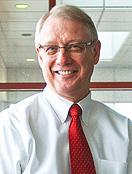Q&A
Donald Antonson
is interim dean for academic affairs and a professor in the Department of Restorative Dentistry, School of Dental Medicine.
What are the big changes in the basic dental curriculum over the past 20 years?
Certainly, an increase in pharmacology because dentists now see so many older patients taking multiple medications. An increase in time devoted to implants, and more on esthetic dentistry. More emphasis on prevention. A trend toward teaching basic science through a “systems” approach. An increased emphasis on infection control. More consideration concerning complex treatment planning—there are so many more options now and, consequently, more complex considerations about what’s right for the patient. Medical histories are more complicated for patients, so that has introduced new material into the curriculum. We now teach students to use magnifiers, and everyone now uses masks and gloves and protective barriers in the clinic—so, practically, we’ve moved toward a more medical model. And always, as we add material, there is general pressure on the curriculum to de-emphasize what is not contemporary.
What changes do you anticipate to accommodate the needs of the dentists starting practice 10 years from now?
The dental profession will have more medical applications of dentistry; for example, saliva will be used as a diagnostic instrument in the dental office. We’ll have more methods for healing a tooth; we know we can reverse or slow down initial dental caries today, so the need to do early restorations will decrease. There will be increased use of lasers in dentistry. We’ll see more implants. There will be a greater emphasis on the aging population. With child and adolescent patients, we’ll use more chemistries, such as fluorides and calcium phosphate pastes, to help keep their teeth stronger and to re-mineralize and even heal lesions from early caries attacks. Still more emphasis on the complicated patient as baby boomers age and lose teeth, including emphasis on removable prosthodontics for the many patients who won’t be able to afford implants and fixed prosthodontic treatments. All this will be reflected in the curriculum.
Has innovation in instructional technology contributed to the evolution of the curriculum?
Educational technology will play a much larger role, and it will speed things up. All students have computers, of course, and their textbooks are electronic; now we’re looking at ways to make teaching materials available on their phones—there’s even instructional information they can download from YouTube. They can plug into Medline to read specific articles. The average printed textbook is five to seven years out of date by the time it is introduced and we can’t wait that long.
Is there a sizeable portion of a four-year pre-doctoral curriculum that simply can’t be altered?
We’ve modified the curriculum recently to have more psychomotor activities earlier in the curriculum because we have limited time to teach those skills. It’s difficult to change curriculum time; in order to add new things to it, we have to make the difficult decision to reduce time spent on other things in the curriculum and that has always been difficult to do—but good schools can do that.
When you look around the country, where do you see curriculum innovation?
It’s possible that we’ll have 20 new dental schools in this country by 2020. Many of these won’t have their own clinics; they’ll outsource students to local practitioners—with the expectation that they can achieve sufficient calibration. These new schools may import basic science faculty to teach modules—for example a three-week package on histology—and then leave. This decreases cost, but educators will have to wait to see whether it is a sound way to teach courses. Some new schools will not be doing research because their faculties will be primarily clinical. The new schools will have less costly physical plants because they aren’t equipping hundreds of dental chairs, so they’ll be able to produce an inexpensive dental education. In the end, time will tell how successful this model can be.
Are these new dental schools contributing to curriculum change?
Yes, both good and bad. They may be introducing more efficiency in teaching. But it may be that the scope of education they offer is too narrow to produce well-rounded professionals.


Reader Comments